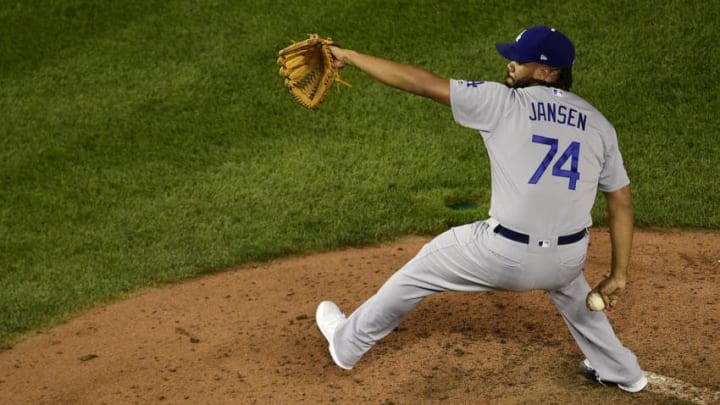Los Angeles Dodgers: Why we can expect a better Kenley Jansen in 2020
By Jason Reed

Kenley Jansen has regressed over the past few seasons but there is a legitimate reason for the Los Angeles Dodgers to expect a better Jansen in 2020.
The Los Angeles Dodgers have won seven consecutive National League West titles in large part due to the team always having a solid pitching staff. So many different players have come and gone and the one constant has been the talent on the bump.
For many of those years, that included closer Kenley Jansen, who was arguably the best closer of the 2010 decade. The best season of his career came in 2017, where he recorded 41 saves with a 1.32 ERA. He allowed 11 runs all year.
The next season was not as great for Jansen, but he was still an all-star. He finished the year with a 3.01 ERA after a very slow start and Dodger fans started to see some troubling signs. Then we look at last season, where Jansen had a 3.71 ERA and eight blown saves.
More from LA Sports Hub
- Lakers: 5 Players to Target Through Trades to make another championship run
- LA Chargers: Week 8 against Denver Broncos is a must-win
- LA Rams: Jared Goff wants to keep the Los Angeles title streak going
- Lakers Rumors: Los Angeles Clippers interested in Rajon Rondo
- LA Chargers: Justin Herbert wins AFC Rookie of the Month
It definitely was not a pretty year for Jansen, his 80.5 save percentage put him 10th in the National League. And with Jansen being 32 and his velocity dipping, many are assuming that his great days are behind him.
His best days are probably behind him, but if you look at Jansen’s advanced metrics, it becomes clear that we could call his 2019 unlucky and we could see a better version of him in 2020.
The first stat that analysts love to look at when it comes to luck for a pitcher is field independent pitching (FIP). FIP calculates what a pitcher’s ERA should have been if that pitcher experienced league-average defense and luck with bounces and such.
Jansen’s FIP was better than his actual ERA, 3.48 to 3.71 (via FanGraphs), but still does not ring out that he was truly unlucky, that he was much better than we are giving him credit for.
The important thing that I like to look at with Jansen is hit spin rates and advanced metrics on batted balls. The narrative around Jansen is that his velocity has dipped, and it certainly has. Jansen ranked in the 34th percentile in fastball velocity last season, which is alarmingly low for a reliever.
However, it is not like Jansen was ever a flamethrower. In 2017, Jansen was in the 60th percentile, which is still pretty low for a reliever. Yes, it is has made a difference in his numbers, but in terms of how guys are hitting Jansen, it really hasn’t.
I was surprised to see that Jansen is still elite in other pitching metrics. He is in the 95th percentile in fastball spin rate, and most importantly, the 99th percentile in hard-hit percentage. Guys still are not hitting the ball hard against Jansen all that often.
The average exit velocity against Jansen in 2019 was 84.6 MPH, only 0.6 MPH higher than his 2017 season. The hard-hit percentage is a bit higher, 26.1 percent to 23.4 percent, but Jansen still ranks in the top 1% of the league in that category.
Jansen ranked in the top 9% of the league in XWOBA, which is expected weighted on-base average and takes into account things such as exit velocity and multiple other factors to give a batter, or pitcher, an average on-base percentage. His .266 XWOBA is up a lot from the .209 XWOBA he posted in 2017, but he is still in the top seven percent.
The one big flaw is that his xSLG, expected slugging percentage, has gone from .271 in 2017 to .345 in 2019. Jansen just allowed more home runs in the last two years. He has allowed 22 home runs combined over the last two seasons, he allowed 20 combined the four years prior.
That is where the dip in velocity comes in. If you look at his vertical and horizontal movement it is all very close to 2017, the problem is that when he missed in 2019, he missed bad. It also does not help that hitters are almost guaranteed a stolen base because Jansen is so slow to the plate, which absolutely makes a difference.
That is one of the most overlooked aspects of Jansen and is something that the Los Angeles Dodgers should have fixed by now. Jansen allowed 12 stolen bases in 2019 with zero caught stealing. That is an issue and is a lot for a closer.
But because the overall numbers, such as exit velocity and his spin rate, are still similar to 2017, we can expect a better Jansen if he just cleans up some things, which he is doing. Jansen has reportedly been working out with Driveline this offseason, which specializes in improving things such as spin rate and velocity with analytic-drive workout programs.
Next. Five bold predictions for the starting rotation. dark
The ship has sailed on 2017 Kenley Jansen and we likely will not see that version of him again. However, I would give Jansen a better chance of having a sub-3.00 ERA in 2020 for the Los Angeles Dodgers than having another season similar to 2019.